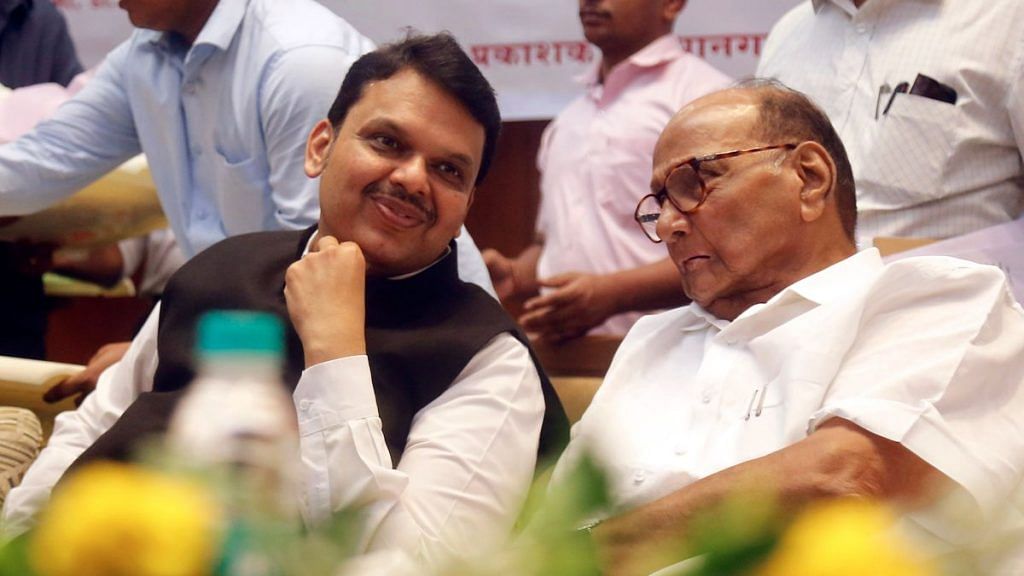Maharashtra Chief Minister Devendra Fadnavis is not known for his literary taste. Like most Rashtriya Swayamsevak Sangh ‘karyakartas’, he too keeps away from modern littérateur class. So, it is unlikely that he would know about Marathi playwright Vijay Tendulkar’s famous play – “Mee Jinkalo, Mee Harlo (I won, I lost)”. The political predicament of Devendra Fadnavis today is succinctly captured in the title of Tendulkar’s play.
The chief minister and his mentors, Prime Minister Narendra Modi and BJP president Amit Shah, were confident that the party would win 200-220 seats in the Maharashtra assembly election. The BJP workers and supporters had even planned their celebrations accordingly. For instance, one of the sweet shops had decided to put up a large display box of ‘370 mammoth laddoos’ to dedicate the election victory to the “revolutionary” scrapping of Jammu and Kashmir’s special status through Article 370. But when the results came out Thursday, Amit Shah’s hopes of securing a “shat pratishat BJP (cent percent BJP)” government in Maharashtra and marginalise its on-off ally Shiv Sena were thoroughly dashed. With only 105 seats in the 288-member assembly (17 seats less than what it got in 2014), the BJP stands nowhere near Maharashtra’s Mantralaya without the help of Shiv Sena’s 56 MLAs (seven less than the last time).
So, will Devendra Fadnavis return to the chief minister’s office? That this question could even be asked shows there is a mood of defeat and depression in the BJP offices across the state.
Also read: Shiv Sena’s Saamana editorial talks of BJP’s ‘politics of arrogance’, praises Sharad Pawar
What worked, what didn’t
Clearly, Narendra Modi’s nine public meetings and Amit Shah’s 16 huge rallies failed to generate the kind of electoral impact that would have supported the PM’s lofty exhortation: “Delhi mein Narendra aur Mumbai mein Devendra”. Similarly, Modi and Shah’s Article 370-driven campaign also failed to impress the voters.
Everything from the so-called ‘Modi magic’ to the great electoral strategies of Amit Shah to the newly carved celebrity image of Devendra Fadnavis failed on various levels.
The rural-agricultural Maharashtra widely expressed its discontent. The agricultural belts had little takers for the BJP and Shiv Sena’s aggressive, Hindutva-fuelled campaign. Droughts, famine, floods, indebtedness, unemployment, and water crisis – issues that the BJP had little time to discuss or raise – played heavily on the voters’ minds.
But it was eventually the urban belt, especially Mumbai and Thane, that saved the BJP from landing in a soup. From the urban chaos – falling bridges, collapsing buildings, commuters dying on suburban tracks, open gutters, increasing pollution – to the slowing economy, nothing budged the BJP’s urban vote bank. In the absence of caste and community not acting as key electoral factors, only two possible explanations emerge: first, the cosmopolitan and liberal social life in Maharashtra’s cities is on a decline; second, there is a near-total absence of the Congress and the NCP, parties that can actually claim to represent liberal values.
Also read: Panga with Sharad Pawar has cost the BJP dearly in Maharashtra
The Sharad Pawar factor
The one person who dashed much of Devendra Fadnavis’s hopes of truly emerging as the BJP’s next-generation leader turned out to be an old warhorse, the Nationalist Congress Party (NCP) president Sharad Pawar. At 79 (he will be 80 in December), Pawar showed he is still one of the most potent leaders in Maharashtra. His campaign was largely a solitary fight. And yet he won more seats for his party (54) than the whole of the Congress put together (44). As was expected, the Enforcement Directorate’s probe against him and his comrade-in-arms, Praful Patel, only helped the NCP.
But Pawar is no Bal Thackeray, whose politics was communal and chauvinistic, and so the NCP chief could never gain enough traction among the Mumbai masses. He is a friend of corporate honchos, higher middle classes, people from art and literature and sports communities, and there is no one in his party who can share or take forward that legacy. Similarly, there is nobody in the Congress to match Pawar’s appeal, either.
Also read: ‘Maratha warrior’ Sharad Pawar shows why he still matters in Maharashtra politics
What next in Maharashtra?
Another factor that could really put a spanner in Devendra Fadnavis’s chances of returning to the CM’s chair is BJP ally Shiv Sena. Although the BJP and the Shiv Sena have had a working majority in the House, the electoral setback has made both of them psychologically (and hence politically) vulnerable. Arithmetically, the Congress (44 seats), the NCP (54 seats) and the Shiv Sena (56 seats) can together form the government a la Karnataka style (where Janata Dal (Secular)’s H.D. Kumaraswamy got the CM post with the Congress’ support despite winning only a few seats). But this so-called algorithm will most likely not go beyond backroom discussions.
The BJP has always been uncomfortable with the Shiv Sena. Since May 2014, the saffron party has sought complete hegemony in Maharashtra. But each time, it had to turn to the Shiv Sena for support, sometimes after the election (2014 assembly), sometimes in advance (2019 assembly).
The thing that irks the BJP the most is the Shiv Sena’s refusal to accept Narendra Modi as the ‘supreme leader’. The Shiv Sena, despite being in power, has largely behaved like an opposition party. This bothers Modi and Amit Shah. But Mumbai-Maharashtra is too important – politically, commercially and culturally – to be left to the Shiv Sena.
The coming days will give a clear picture about which way the BJP-Shiv Sena relationship is headed. It might turn out to be more of the same. But as far as the BJP’s invincibility is concerned, there are ample signs that we have seen the peak of ‘Modi wave’ and it is only going to crash now, slowly but surely.
The author is a former editor and Congress member of Rajya Sabha. Views are personal.
